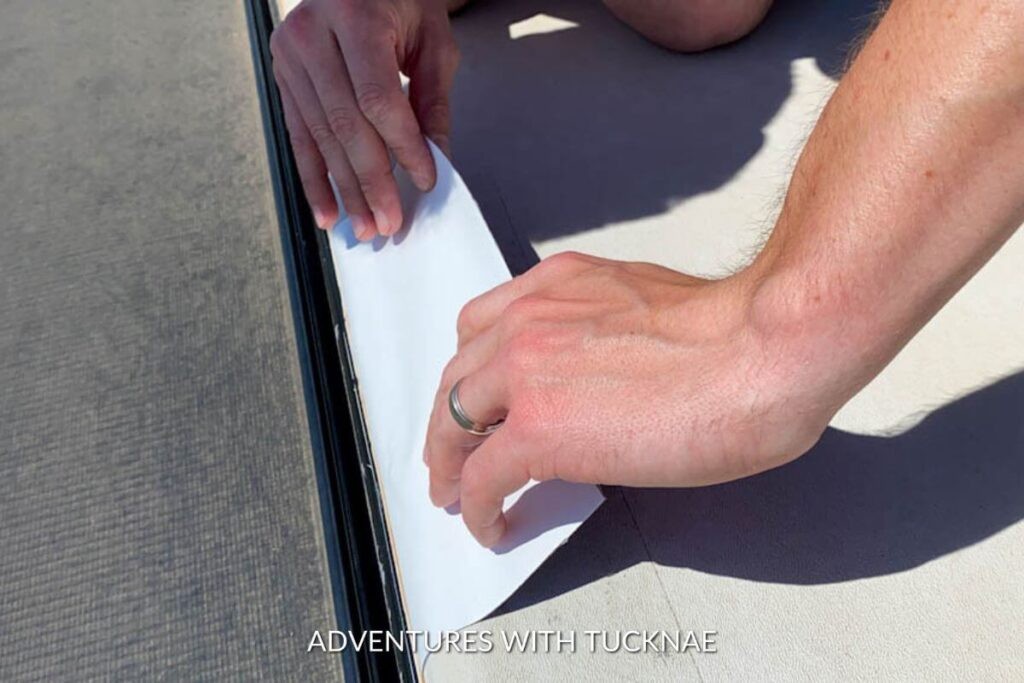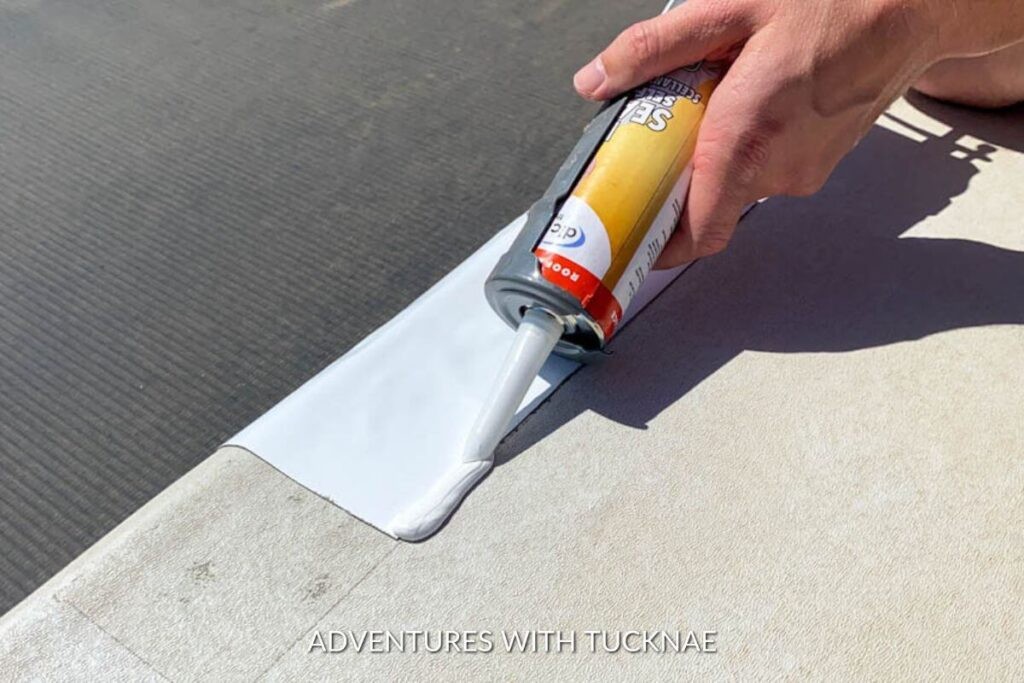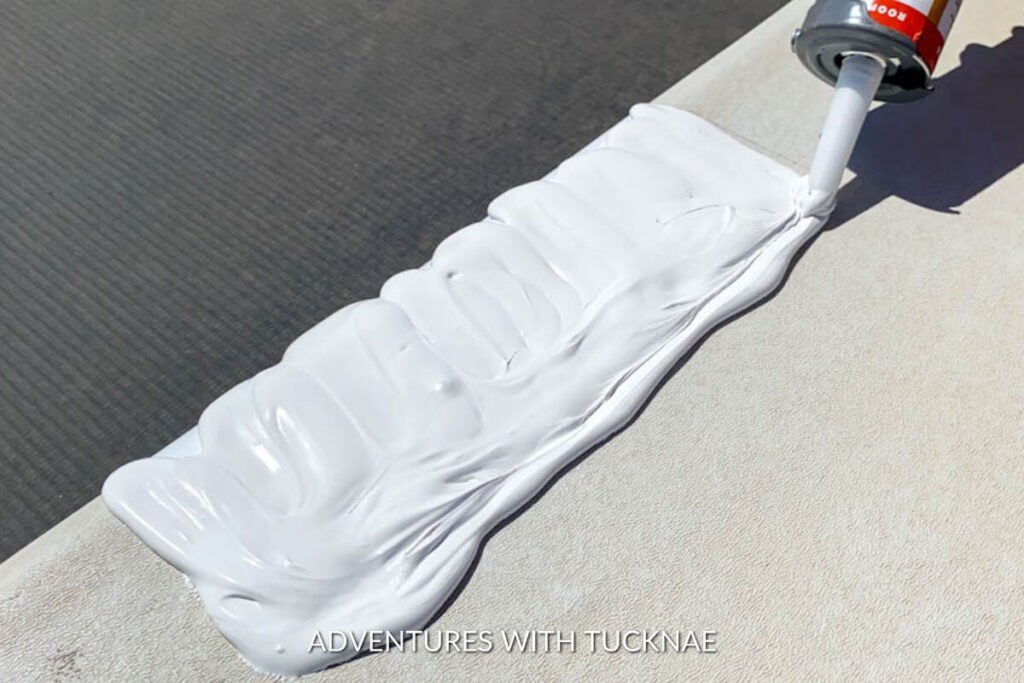Is your travel trailer roof showing signs of wear and tear? Don’t let a leaky roof ruin your travel adventures. At TRAVELS.EDU.VN, we understand the importance of maintaining your RV and ensuring it’s ready for the open road. This guide provides you with comprehensive insights on how to fix a travel trailer roof efficiently and cost-effectively, ensuring your peace of mind during your travels. Protecting your investment has never been easier with our expert advice and step-by-step instructions. Learn about RV roof maintenance, sealant options, and leak prevention.
1. Understanding Travel Trailer Roof Issues
Travel trailer roofs are constantly exposed to the elements, making them susceptible to damage. From sun exposure and harsh weather conditions to tree branches and debris, several factors can compromise the integrity of your RV roof. Understanding these potential issues is the first step in preventing and addressing them effectively. The most common RV roof problems include leaks, punctures, tears, and general wear and tear.
1.1. Common Culprits Behind Roof Damage
- Weather: Extreme temperatures, heavy rain, snow, and hail can cause significant damage to your RV roof.
- UV Rays: Prolonged exposure to the sun’s ultraviolet (UV) rays can degrade the roofing material over time, leading to cracks and brittleness.
- Tree Branches: Low-hanging tree branches can scratch, puncture, or tear the roof’s surface.
- Debris: Falling debris, such as leaves, twigs, and rocks, can accumulate on the roof, trapping moisture and promoting mold growth.
- Lack of Maintenance: Neglecting regular inspections and maintenance can exacerbate minor issues, leading to more extensive and costly repairs.
1.2. Types of RV Roofing Materials
Identifying the type of roofing material on your travel trailer is crucial for selecting the appropriate repair methods and materials. The most common types of RV roofing materials include:
- EPDM Rubber: Ethylene Propylene Diene Monomer (EPDM) rubber is a durable, flexible, and relatively inexpensive roofing material commonly used in RVs.
- TPO: Thermoplastic Polyolefin (TPO) is a lightweight, heat-reflective roofing material known for its resistance to UV rays, chemicals, and punctures.
- Fiberglass: Fiberglass is a strong, durable roofing material that offers excellent resistance to impact and weather damage.
- Aluminum: Aluminum roofs are lightweight and corrosion-resistant, making them a popular choice for travel trailers.
2. Essential Tools and Materials for RV Roof Repair
Before embarking on any RV roof repair project, it’s essential to gather the necessary tools and materials. Having the right equipment on hand will not only streamline the repair process but also ensure a professional and long-lasting result.
2.1. Comprehensive Checklist of Tools and Materials
- Cleaning Supplies:
- RV roof cleaner or mild detergent
- Soft-bristled brush
- Rags or paper towels
- Rubbing Alcohol
- Safety Equipment:
- Ladder
- Safety harness
- Non-slip shoes
- Gloves
- Safety glasses
- Repair Materials:
- RV roof sealant (compatible with your roofing material) – Like Dicor 501LSW-1 EPDM Self-Leveling Lap Sealant.
- RV roof repair tape (e.g., Eternabond RV Rubber Roof & Leak Repair Tape)
- Patch material (if needed)
- Tools:
- Caulk gun
- Scissors or utility knife
- Measuring tape
- Putty knife or scraper
- Seam roller (optional, but recommended for applying repair tape)
2.2. Selecting the Right Sealant and Repair Tape
Choosing the right sealant and repair tape is crucial for ensuring a watertight and durable repair. Consider the following factors when selecting these materials:
- Compatibility: Ensure that the sealant and repair tape are compatible with your RV’s roofing material. Using incompatible products can lead to adhesion issues and premature failure.
- Weather Resistance: Opt for sealants and repair tapes that are specifically designed for outdoor use and can withstand extreme temperatures, UV rays, and moisture.
- Flexibility: Choose flexible sealants and repair tapes that can accommodate the expansion and contraction of the roof due to temperature changes.
- Durability: Select high-quality sealants and repair tapes that offer long-lasting protection against leaks and damage.
3. Step-by-Step Guide: How to Fix a Travel Trailer Roof
Now that you have the necessary tools and materials, let’s dive into the step-by-step process of how to fix a travel trailer roof. Follow these instructions carefully to ensure a successful and watertight repair.
3.1. Thoroughly Inspecting the Roof
Before beginning any repairs, conduct a thorough inspection of your RV roof to identify all areas of damage. Look for cracks, punctures, tears, blisters, and any signs of water damage.
- Visual Inspection: Carefully examine the entire roof surface, paying close attention to seams, vents, skylights, and other roof penetrations.
- Tactile Inspection: Gently feel the roof surface for soft spots or areas that feel spongy, which may indicate underlying water damage.
- Interior Inspection: Check the interior of your RV for water stains, discoloration, or mold growth, which can be signs of a leaky roof.
3.2. Cleaning the Affected Area
Properly cleaning the affected area is crucial for ensuring proper adhesion of the repair materials.
- Remove Debris: Use a soft-bristled brush to remove any loose debris, dirt, or leaves from the roof surface.
- Wash the Area: Clean the affected area with an RV roof cleaner or mild detergent and water. Rinse thoroughly and allow the area to dry completely.
- Remove Old Sealant: If there is old or damaged sealant around the area to be repaired, carefully remove it with a putty knife or scraper.
- Use Rubbing Alcohol: To finalize, clean the roof with rubbing alcohol and let it dry completely before moving on.
3.3. Applying RV Roof Repair Tape
For small punctures, tears, or seam leaks, RV roof repair tape can provide a quick and effective solution.
- Measure and Cut: Measure the area to be repaired and cut a piece of RV roof repair tape that is slightly larger than the damaged area.
- Peel and Apply: Peel off the backing from the repair tape and carefully apply it over the damaged area, ensuring that it extends beyond the edges of the damage.
- Smooth and Seal: Use a seam roller or your fingers to smooth out the repair tape and ensure a tight seal. Apply firm pressure to remove any air bubbles and ensure proper adhesion.
 Applying Externabond tape over the hole in our travel trailer roof. The tape is being carefully applied to ensure it covers the entire damaged area.
Applying Externabond tape over the hole in our travel trailer roof. The tape is being carefully applied to ensure it covers the entire damaged area.
3.4. Sealing with Lap Sealant
After applying RV roof repair tape, it’s essential to seal the edges with lap sealant to provide an extra layer of protection against water intrusion.
- Apply Sealant: Using a caulk gun, apply a bead of lap sealant around the edges of the repair tape, ensuring that it completely seals the edges and creates a watertight barrier.
- Smooth Sealant: Use your finger or a putty knife to smooth the sealant and ensure a clean, professional finish.
- Allow to Cure: Allow the sealant to cure according to the manufacturer’s instructions. This may take several hours or even days, depending on the product and environmental conditions.
 Applying the Dicor lap sealant with a caulk gun during our RV roof repair. The sealant is being carefully applied to cover the hole in our trailer roof, ensuring a watertight seal.
Applying the Dicor lap sealant with a caulk gun during our RV roof repair. The sealant is being carefully applied to cover the hole in our trailer roof, ensuring a watertight seal.
3.5. Patching Larger Holes
For larger holes or areas of extensive damage, patching may be necessary to restore the integrity of the roof.
- Cut Patch Material: Cut a piece of patch material (e.g., EPDM rubber or TPO membrane) that is slightly larger than the damaged area.
- Apply Adhesive: Apply a compatible adhesive to both the patch material and the roof surface around the damaged area.
- Position Patch: Carefully position the patch over the damaged area and press firmly to ensure proper adhesion.
- Seal Edges: Seal the edges of the patch with lap sealant, following the same procedure as described above.
4. Preventive Measures to Extend Your RV Roof’s Lifespan
Prevention is always better than cure, and taking proactive measures to protect your RV roof can save you time, money, and headaches in the long run. Here are some preventive measures to extend your RV roof’s lifespan:
4.1. Regular Inspections and Maintenance
- Inspect Regularly: Conduct regular inspections of your RV roof, ideally every few months, to identify and address any potential issues early on.
- Clean Regularly: Clean your RV roof regularly to remove debris, dirt, and leaves that can trap moisture and promote mold growth.
- Re-seal Seams: Re-seal the seams and roof penetrations every few years to maintain a watertight seal.
4.2. Protecting Against the Elements
- Cover Your RV: When storing your RV for extended periods, consider using a RV cover to protect it from the elements.
- Park in Shaded Areas: When possible, park your RV in shaded areas to reduce exposure to UV rays.
- Use a UV Protectant: Apply a UV protectant to your RV roof to help prevent sun damage.
4.3. Addressing Issues Promptly
- Fix Leaks Immediately: If you notice any signs of a leaky roof, address the issue immediately to prevent further damage.
- Repair Damage Promptly: Repair any cracks, punctures, or tears as soon as possible to prevent them from worsening.
5. When to Call a Professional
While many RV roof repairs can be tackled as DIY projects, there are certain situations where it’s best to call a professional. If you’re uncomfortable working on your RV roof or if the damage is extensive, it’s always a good idea to seek professional help.
5.1. Situations Requiring Professional Assistance
- Extensive Damage: If your RV roof has extensive damage, such as large holes, significant water damage, or structural issues, it’s best to consult with a professional RV repair technician.
- Lack of Experience: If you’re not comfortable working on your RV roof or if you lack the necessary experience, it’s always better to err on the side of caution and seek professional help.
- Warranty Concerns: If your RV is still under warranty, attempting to repair the roof yourself may void the warranty.
5.2. Finding a Reputable RV Repair Technician
- Ask for Recommendations: Ask friends, family, or fellow RVers for recommendations.
- Read Online Reviews: Check online reviews and ratings to get an idea of the technician’s reputation and quality of work.
- Verify Credentials: Ensure that the technician is licensed and insured.
- Get Multiple Quotes: Obtain multiple quotes from different technicians to compare prices and services.
6. Cost Considerations for RV Roof Repair
The cost of RV roof repair can vary widely depending on the extent of the damage, the type of roofing material, and whether you choose to DIY or hire a professional.
6.1. DIY vs. Professional Repair Costs
- DIY Repair: DIY RV roof repairs are typically less expensive, as you only need to pay for the necessary tools and materials. A simple DIY repair can cost less than $50, as demonstrated in the original article.
- Professional Repair: Professional RV roof repairs can be more expensive, as you’ll need to factor in labor costs in addition to the cost of materials.
6.2. Factors Affecting Repair Costs
- Extent of Damage: The more extensive the damage, the higher the repair costs will be.
- Roofing Material: The type of roofing material can also affect repair costs, as some materials are more expensive to repair or replace than others.
- Labor Costs: Labor costs can vary depending on the technician’s experience, location, and hourly rate.
7. Real-Life Examples and Case Studies
To further illustrate the concepts discussed in this guide, let’s take a look at some real-life examples and case studies of RV roof repairs.
7.1. Case Study 1: Small Leak Repair
Problem: A small leak was detected around a roof vent in a travel trailer.
Solution: The owner cleaned the area around the vent, applied RV roof repair tape to seal the leak, and then sealed the edges with lap sealant.
Result: The leak was successfully repaired, preventing further water damage.
7.2. Case Study 2: Roof Patching
Problem: A large hole was discovered in the roof of a fifth-wheel RV due to a fallen tree branch.
Solution: The owner cut a patch from a sheet of EPDM rubber, applied adhesive to both the patch and the roof surface, and then positioned the patch over the hole. The edges of the patch were then sealed with lap sealant.
Result: The hole was successfully patched, restoring the integrity of the roof.
8. TRAVELS.EDU.VN: Your Partner in RV Maintenance
At TRAVELS.EDU.VN, we’re passionate about helping RVers maintain their vehicles and enjoy worry-free travels. Our comprehensive guides, expert advice, and top-quality products are designed to make RV maintenance easier and more affordable.
8.1. How TRAVELS.EDU.VN Can Help
- Expert Advice: Our team of RV experts is available to answer your questions and provide personalized advice on RV roof repair and maintenance.
- Top-Quality Products: We offer a wide selection of top-quality RV roof repair products, including sealants, repair tapes, and patch materials.
- Convenient Online Shopping: Shop for RV roof repair products from the comfort of your own home with our convenient online store.
8.2. Special Offers for Napa Valley Travelers
Are you planning a trip to Napa Valley? Let TRAVELS.EDU.VN help you make the most of your experience with our exclusive RV rental and service packages. Contact us today to learn more about our special offers for Napa Valley travelers.
9. Frequently Asked Questions (FAQs)
9.1. What is the best way of repairing an RV roof leak? DIY or hire some professionals?
If the leak in your RV roof is a small area, the best way to repair it is to follow our step-by-step guide and repair the damaged area yourself to fix the small leak. If there is extensive damage, then the problem area might need to be assessed by professional repair services.
9.2. How much does an RV roof repair cost?
A simple RV roof repair, as we did on our repair job, is relatively inexpensive and should cost less than $50 for DIY RV owners. To replace an entire RV roof with significant damage would result in much more costly repairs.
9.3. How often should I inspect my RV roof?
You should inspect your RV roof at least every three months, and more frequently if you travel in areas with harsh weather conditions.
9.4. What type of sealant should I use on my RV roof?
Use a sealant that is specifically designed for RV roofs and is compatible with your roofing material. Lap sealant is a popular choice for sealing seams and roof penetrations.
9.5. Can I walk on my RV roof?
Most RV roofs are designed to be walkable, but it’s always a good idea to check your owner’s manual to be sure. When walking on your RV roof, wear non-slip shoes and avoid stepping on any areas that feel soft or spongy.
9.6. How long does RV roof repair tape last?
RV roof repair tape can last for several years if applied properly and maintained regularly. However, it’s important to inspect the tape regularly and replace it if it shows any signs of damage.
9.7. What is the best way to clean my RV roof?
The best way to clean your RV roof is to use a soft-bristled brush and an RV roof cleaner or mild detergent and water. Avoid using harsh chemicals or abrasive cleaners, as these can damage the roofing material.
9.8. Can I use regular household caulk on my RV roof?
No, you should not use regular household caulk on your RV roof. Household caulk is not designed to withstand the extreme temperatures and weather conditions that RV roofs are exposed to.
9.9. How do I prevent mold growth on my RV roof?
To prevent mold growth on your RV roof, keep it clean and dry. Remove any debris that can trap moisture, and ensure that your RV is properly ventilated.
9.10. Where can I find more information about RV roof repair and maintenance?
You can find more information about RV roof repair and maintenance on the TRAVELS.EDU.VN website or by contacting our team of RV experts.
10. Ready to Get Started? Contact TRAVELS.EDU.VN Today
Don’t let a leaky RV roof ruin your travel adventures. Contact TRAVELS.EDU.VN today for expert advice, top-quality products, and exclusive offers for Napa Valley travelers. Let us help you keep your RV in top condition so you can focus on enjoying the open road.
Contact Information:
- Address: 123 Main St, Napa, CA 94559, United States
- WhatsApp: +1 (707) 257-5400
- Website: travels.edu.vn
Our team is ready to assist you with all your RV roof repair and maintenance needs. Whether you’re looking for advice, products, or professional services, we’re here to help. Contact us today and let us help you keep your RV in top condition for years to come.
 Our RV roof repair finished product with Dicor lap sealant applied to cover the hole in our trailer roof. The sealant has been neatly applied, providing a smooth and watertight finish.By following these steps and guidelines, you can effectively fix a travel trailer roof and ensure your RV is ready for your next adventure. Remember to prioritize safety, use the right materials, and don’t hesitate to seek professional help when needed. With proper care and maintenance, your RV roof can provide years of reliable protection.
Our RV roof repair finished product with Dicor lap sealant applied to cover the hole in our trailer roof. The sealant has been neatly applied, providing a smooth and watertight finish.By following these steps and guidelines, you can effectively fix a travel trailer roof and ensure your RV is ready for your next adventure. Remember to prioritize safety, use the right materials, and don’t hesitate to seek professional help when needed. With proper care and maintenance, your RV roof can provide years of reliable protection.
